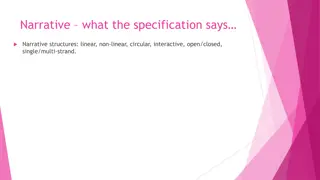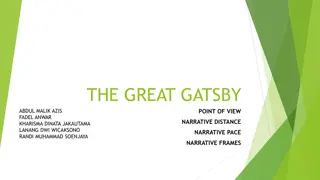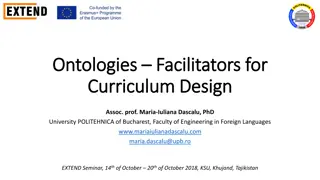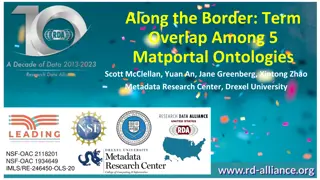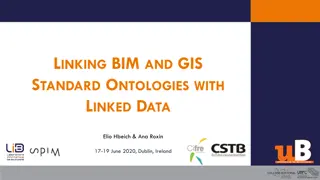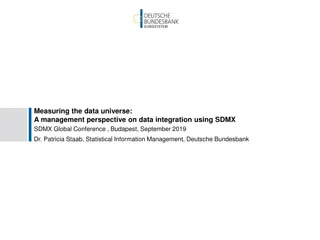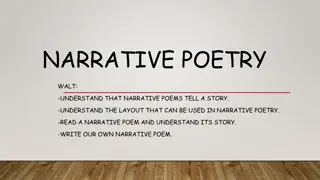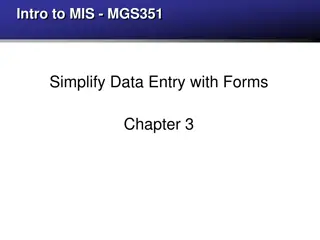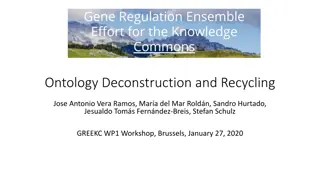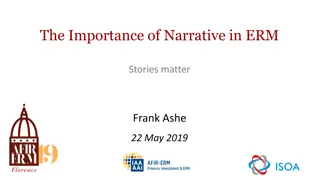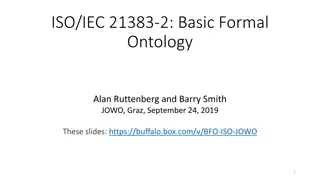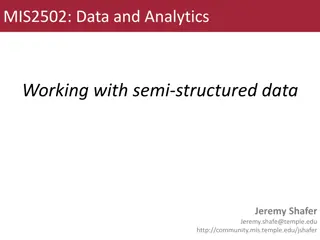Describing Ontologies in Narrative Form Using Structured English
Structured English approach to describing ontologies, including elements such as terms, attributes, relationships, and constraints. Dive into examples and constraints/rules while understanding the significance of a clear and unambiguous documentation process.
Download Presentation

Please find below an Image/Link to download the presentation.
The content on the website is provided AS IS for your information and personal use only. It may not be sold, licensed, or shared on other websites without obtaining consent from the author.If you encounter any issues during the download, it is possible that the publisher has removed the file from their server.
You are allowed to download the files provided on this website for personal or commercial use, subject to the condition that they are used lawfully. All files are the property of their respective owners.
The content on the website is provided AS IS for your information and personal use only. It may not be sold, licensed, or shared on other websites without obtaining consent from the author.
E N D
Presentation Transcript
Describing Ontologies in Narrative Form Using Structured English MARTIN SCHEDLBAUER, PH.D. M.SCHEDLBAUER@NEU.EDU
2 Elements of an Ontology Terms Attributes Relationships Constraints & Rules Multiplicities, cardinalities, organizational rules or government regulations Things, physical objects, abstract concepts, places, roles, events, relations Properties of an entity, measurements, quantities Facts expressed in taxonomy, partonomy, association relationships
3 Relationships in Ontologies 1 2 3 Taxonomy is-a-kind-of (aka is-a ) hierarchy Partonomy is-a-part-of hierarchy Associations has-a (aka is- linked-with) relationship
4 Example Ontology Elements A book is a term (also referred to as entity or class) A page is a term An author is a term A page is part of a book(partonomy) An e-bookis a kind ofbook (taxonomy) A bookcontains at least three pages (multiplicity constraint) A book has an author (association) A book may not have any author (multiplicity constraint) A book has a publication date (property)
5 Structured English
6 Structured English We need a way to reduce ambiguity when documenting ontologies. Structured English is a form of a structured narrative that allows us to document: terms and facts constraints and rules relationships and multiplicities Of course, a structured narrative can be in a language other than English.
7 Constraints & Rules A Constraint or Rule describes a policy, guideline, standard, or regulation which is present in a domain is a statement that defines or constrains some aspect of a domain is intended to assert structure, or to control or influence the behavior of people, organizations, or information systems Constraint definitions must be atomic, i.e., they must not be further decomposable, and they may not be context-dependent.
Examples of Constraint Rules Possible constraint rules for a rental car agency: A vehicle may not be rented and must be scheduled for repair under any of the following conditions: All vehicles must be inspected prior to being released to the customer. more than 6,000 miles since the last service The customer must acknowledge the inspection results by signing the inspection form. a customer reported an issue with the brakes brake warning light is illuminated fluid leaks are present check engine light is illuminated 8
9 Constraint Lifecycle Document constraint analysis process analysis information collection internal: programming, database constraints external: business rules engine formally: ontologies informal narratives structured narratives decision tables decision trees UML models Identify Encode
10 Practical Considerations During the modeling process, identify: consequences of a constraint violation, i.e., what would happen if a constraint were violated constraint enforcement system process individual checks-and-balances external agency (e.g., regulatory body, auditor)
11 Best Practices for Defining Constraints A well-written constraint definition is: cohesive and non-compound, i.e., it describes a single constraint which makes constraints more reusable and easier to validate expressed in a form that is easy to understand by domain experts, information analysts, and programmers augmented by decision tables, decision trees, and visual models intrinsic to the business and not specific to one system expressed independently from its enforcement
12 Types of Constraints Constraints may include the following types: Definitions of terms Conditions and actions Data integrity Mathematical and functional derivations Logical inferences Processing sequences Relationships among terms
13 Stakeholders & SMEs Informal Narratives Development Cycle Structured Narratives Analysts Models & Rules internal through program code Programming Constructs Programmers external through BRMS
14 Documentation Techniques There are several useful techniques for documenting and analyzing constraints: Structured Narratives Decision Tables Decision Trees Data Models (generally as UML Class Diagrams) State Charts (generally as UML State Diagrams)
15 Technique: Structured Narrative Narrative definition of a constraint rule (facet) in a natural language: It must always hold that a customer s driver s license has an expiration date at least one month past the end date of the vehicle rental period.
16 Essential Modeling Concepts Constraint rules are based on these concepts: Terms Facts Assertions Derivations Policies Constraints (or constraint rules) are often known as business rules.
17 Business Rule Manifesto Rules build on facts, and facts build on concepts as expressed by terms. Terms express business concepts; facts make assertions about these concepts; rules constrain and support these facts.
18 Essential Concept: Term A term is a noun or noun phrase that has a special meaning for the business. Terms are commonly entities (classes) in the business domain. Example terms for a car rental business: reservation vehicle service appointment customer
19 Sources of Terms A term is an entity in the business domain: customer, invoice, sale, vehicle Use information discovery methods to find terms from use cases and other narrative descriptions of business processes and system interactions. Watch for nouns in descriptions of processes.
20 Properties Terms generally have properties that describe information about them such as attributes: reservation date cost vehicle VIN make model
21 Essential Concept: Fact A fact is an association (relationship) between two or more terms or a term and a property. Example facts for a car rental business: A vehicle is located at a branch. A customer books a reservation for a vehicle. Name is an attribute of customer. A customer is a kind of person. Facts can be stated in more than one way. A visual data model (e.g., entity-relationship or class diagram) is a visual representation of facts.
22 Essential Concept: Assertion An assertion is a kind of constraint that specifies when an action is allowed to occur and when it is not: conditions authorizations Example assertions for a car rental business: a reservation is for one customer only a reservation must contain the reservation date only a manager may override the daily rental charge
23 Essential Concept: Derivations A derivation is a rule that infers a value from other values (generally attributes). Example derivations for a car rental business: if rental date is during peak season, then increase the base daily rental charge by 10% rental charge = (daily rental charge * number of rental days) + (hourly rental charge * number of overdue hours) + sales tax + (number of gallons of fuel * fuel price) + insurance
How does this all relate? 24 If any lights are broken, they must be repaired. We only rent clean vehicles in roadworthy condition. is source of Narrative Statement Policy 1..* 1..* 1..* results in 1..* expressed in Formal Rule Statement Business Rule 1 1..* A vehicle with a broken light must be scheduled for service and may not be rented. IF vehicle.state == BROKEN THEN invoke service(vehicle.id)
25 Structured Narratives Structured Narratives are a modified form of English for precisely specifying constraints and rules. It uses a subset of English that is limited to: action verbs and noun phrases, and eliminates qualifiers in the form of adjectives or adverbs IT MUST ALWAYS HOLD THAT an item that is sold to a customer is in stock
26 Conditional Assertion Rules Conditional assertions are rules that define what conditions must be met before an activity is allowed to take place. Defined with WHEN and IF clauses: WHEN the in-stock level is below the reorder threshold THEN place order with distributor WHEN an order is placed by a customer IF the customer does not have a line of credit THEN request deposit ELSE waive deposit
27 Operation Constraint Rules These rules define constraints that must hold before and/or after an activity. Specified with IS CORRECTLY COMPLETED and ONLY IF clauses: Placing an order IS CORRECTLY COMPLETED ONLY IF the order has been placed with the distributor AND the item's on-order count has been updated
28 Invariant Constraint Rules These rules define conditions about associations or attributes values between classes (terms) and property (attribute) values that must always be true. Specified with IT MUST ALWAYS HOLD THAT clauses: IT MUST ALWAYS HOLD THAT a project may not have more than 12 members IT MUST ALWAYS HOLD THAT for any given retirement account the account owner is not the primary beneficiary
29 Inferential Derivation These rules describe derivations for facts that can be inferred from other facts. Specified with IF AND ONLY IF and IF THEN clauses: An item is in inventory IF AND ONLY IF the item is carried by at least one distributor IF an item is no longer made THEN the item is discounted by 20%
30 Computational Derivations These derivation rules describe processing algorithms or mathematical formulae. Specified with IS COMPUTED AS FOLLOWS clauses: The default retail price of an item IS COMPUTED AS FOLLOWS retail price = cost * (1 + markup) where default markup = 20% (0.20) {does not include tax}
31 Constraint Rule Scope Constraint rules may be applicable: globally locally temporally
32 Examples: Constraint Scope (during order processing) IT MUST ALWAYS HOLD THAT an item that is sold to a customer is in stock (after 7/1/87) A person is a contractor IF AND ONLY IF the person works for at least one other company (always) IT MUST ALWAYS HOLD THAT a contractor is paid an hourly wage
33 Best Practices Follows these general guidelines when writing constraint rules as Structured Narratives: Ensure statements are not ambiguous Use a standard set of narrative templates Capitalize keywords Indent statements to illustrate the logical hierarchy Place each statement on a separate, indented line Underline terms defined in the data dictionary Add comments in braces ({ }) Use parentheses to clarify logical precedence
34 Summary & Questions




